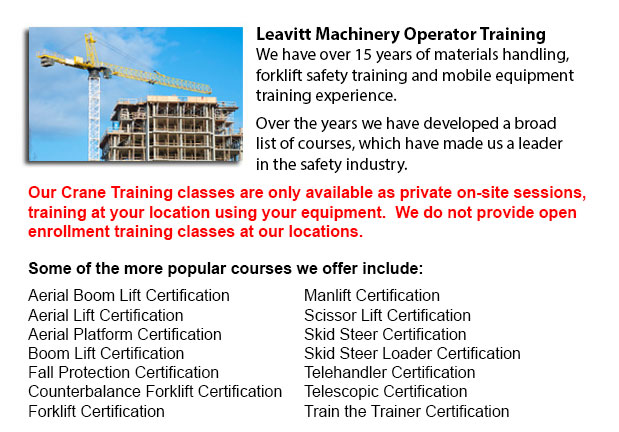
Overhead Crane Operator Training British Columbia - The course teaching overhead crane operator training has been meant particularly to instruct trainees on the fundamentals of pre-shift checks and overhead crane/sling operation. The programs are instructed by professional trainers and consultants. Well-trained employees are more productive and efficient, that actually saves on costs associated with product damage, property damage, and accidents due to the use of improper operating procedures. Our overhead crane certification is customized for staff who have literacy barriers, reducing certification time by 50 per cent.
Overhead cranes are suitable for specific repetitive hoisting activities. This kind of crane has wide ranging capacities. They can be used for specialized hoisting jobs such as removing or installing major plant machinery.
Worker and operators should employ safe rigging practices to be able to safely operate an overhead crane. This would need both practice and knowledge because the load needs to be properly rigged to guarantee its stability when lifted. Prior to beginning a hoisting task, it must be determined that the crane is right for the job, with appropriate travel, lift and capacity. The crane must be subjected to a thorough physical and visual check before utilization. The capacity of all equipment, including the slings, hardware and rope, should never exceed load weight capacities.
Before utilizing the rigger must know what sling is right for every lift and must check the rigging hardware and gear. The communications that are utilized with the crane operator have to be clear and concise. A signaler must be designated for the role and signals need to be agreed upon. The crane operator has to follow instructions from the chosen person only. If a remote or wired controller is being utilized, the operator must be trained in all its functions.
To be able to guarantee the safety of workers, a warning should be issued and the path of the load must be cleared of all hazards before the lift begins. People must not be allowed to walk under the lift loads. The crane hoist must be centered over the load before lifting in order to prevent swinging. The safety catch needs to be closed instantly after sliding the sling fully onto the lifting hook. Sling legs that are not used must be secured so they do not drag. Never leave loose materials on a load being lifted. Watch that fingers and hands are clear when slack is taken out of a sling. Step clear of the danger zone before the lift is made.
-
Warehouse Forklift Safety Training British Columbia
Warehouse Forklift Safety Training British Columbia - The corporation would face claims for liability when damage and injuries are sustained in an accident at the workplace. Warehouses can be a hazardous place to work for its workers, making employee... More -
Loader Operator Certification British Columbia
Loader Operator Certification British Columbia - Courses Offered For Getting Loader Operator Certification - Certification for forklifts are required to guarantee the safe operation of forklifts for those employers in industrial, warehouse or constru... More -
Crane / Overhead Crane / Self-Erect Crane / Truck Mounted Crane / Hydraulic Cranes Training in British Columbia
Bridge cranes or likewise called overhead cranes are actually a type of industrial material handling crane making use of a line and hook device that runs on a horizontal beam running along two widely separated rails. Numerous overhead cranes could be... More -
Scissor Lift License British Columbia
Scissor Lift License British Columbia - The operation of scissor lifts carries an inherent chance of danger. Whichever type of powered machine requires correct handling to prevent accidents causing injury or damage. Companies need to make certain tha... More -
Heavy Equipment Training Schools British Columbia
Heavy Equipment Training Schools British Columbia - There are a lot of heavy equipment training schools to select from. If you want to get to the best, it is important to check various aspects of the school in order to ascertain the level of educatio... More -
Telehandler Training British Columbia
Telehandler Training British Columbia - Telescopic handlers usually called telehandlers for short, are an extremely popular piece of heavy construction equipment. They are commonly utilized in the construction and agricultural trades. These machines... More -
Forklift Training Courses British Columbia
Forklift Training Courses British Columbia - When forklift operator safety training is tailored for illiteracy, training time is lessened by 50%. Forklift training certification, lift-truck operator driver safety training evaluation, and train the tr... More -
Heavy Equipment Operator Training British Columbia
Heavy Equipment Operator Training British Columbia - Heavy equipment operator training facilities which provide quality standards in the business, providing field performance work and added machinery training are highly sought after training features... More

Forklift Training British Columbia
TOLL FREE: 1-888-254-6157
forklifttrainingbritishcolumbia.com
Email Us
About Us


